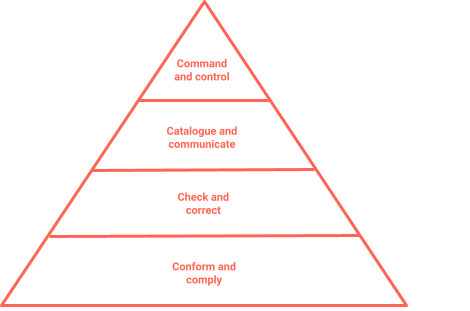Everything you need to know about people-oriented leadership
Georgina Guthrie
April 14, 2021
Picture a triangle, point up like a pyramid. When it comes to traditional workplaces, things tend to be run in this top-down kind of way. The managers are at the top, pulling the strings and making the decisions, with decreasing layers of authority underneath.

A typical hierarchical structure
These types of structures tend to be more common in larger, traditional organizations. The leaders are task-oriented, meaning they focus on tasks, processes, and deadlines. Decision-making may be democratic-ish, insofar as everyone has a say — but ultimately, it’ll be those at the top who decide.
People-oriented businesses, on the other hand, tend to be more bottom-up. Everyone chips in with decision-making, and each voice is as important as the other. While there usually is a manager or founder who gets the final say, the overall structure is far flatter. This type of structure is common in startups and smaller businesses. Though progressive, creative companies like Google, Pixar, and Netflix put people over processes.
People-oriented leadership is often seen as being at odds with task-oriented leadership. But, it would be a mistake to think of them as being completely separate. Both have the same goal in mind: the success of the company. They just go about it in slightly different ways. Let’s unpack these terms a little more.
What is people-oriented leadership?
People-oriented leadership puts the team and its well-being first. The driving force behind it is the idea that workers are your most important asset. If they’re happy, everything else will follow. This contrasts with an objective style of leadership, which places objectives and goals above all else. Ideally, this is not at the expense of employee well-being; both are important.
As a leader, it’s up to you to work out which route you think will work best in your organization. There are pros and cons to each — which we’ll go into a little more detail now.
What are the advantages of people-oriented leadership?
People-oriented leaders are more focused on the well-being, development, and involvement of the team. Decision-making is far more democratic, with everyone’s voice being seen as equal — no matter what their role, nor how long they’ve been in the company.
The best way to understand whether or not this is right for your organization is to understand the outcomes it can bring. Here are some of the advantages:
- An inclusive atmosphere
Team members feel like a valued, integral part of the business because they can see their voice counts. - Insight into employee mood
The business has more understanding of the mood of its workers:. If workers feel the company listens to them, they’ll be more likely to share good things as well as difficulties they may be experiencing. This gives them the opportunity to solve issues before they snowball into bigger ones. - Engaged employees
Team members feel more aligned to the company objectives because they’ve helped shape them — making it easier for individuals to slot their day-to-day efforts into the bigger picture. - A motivation boost
Employees who feel valued and listened to are more likely to feel motivated, which could lead to lower staff turnover and better productivity. - New ideas and fresh thinking
People-oriented leadership gives equal precedence to all voices — meaning ideas and fresh thinking from less senior employees have more opportunity to be heard. This, in turn, fuels creativity, innovation, and agility — helping the company improve and stay current.
What are the disadvantages?
As with all management styles, there are drawbacks. And people-oriented leadership is no different.
- Slower decision-making
Blurring the lines between subordinates and leaders can slow decision-making down. This is something that’s especially problematic when you need to make snappy choices. This can be avoided by assigning leader roles, meaning that when people are struggling to reach a decision, there’s someone who can step in and exert authority. - Employee resentment
The downside to having someone step in and make a final decision is that employees who are used to seeing their decisions come to fruition might resent that opportunity being taken away from them. To avoid this, leaders should take steps to implement firm boundaries, explain the structure, and reassure employees that their voices are important, but that in certain situations, there will be someone who leads. This should help quell any resentment. - People-first isn’t right for you
In other instances, people-oriented leadership simply won’t work. For example, if the organization is particularly large — or the nature of the work is more formulaic — for example, production line work. Though it might not be possible to implement a people-first way of working, organizations can still take steps to help employees feel valued and heard. Things like team catch-ups and company discussion sessions are all good options.
People-oriented leadership vs. Task-oriented leadership: Which one should you choose?
The route you choose should depend on the way your organization operates, rather than the way things are at the moment. After all, organizational change is possible — even within big companies. Here are some questions to ask yourself to help guide your choice:
- Would you prefer to focus on the task, or the people doing it?
- Would it be better to focus on methods and strategies, or the way things are done?
- Does your organization value structure and procedures, or are innovation and creativity a priority?
- Does your organization value respect and hierarchies, or are rapport and a communal atmosphere more important?
- Would your organization benefit from clearly defined boundaries when it comes to communication and decision-making, or is it important everyone feels they have equal standing?
If you find yourself more drawn to the first option in each of these questions, then task-oriented leadership might be for you. If you’re drawn to the second option, you may benefit from a people-oriented approach.
Of course, things are less clear-cut in the business world, and there are intricacies that will arise when approaches are put into practice.
You may find your business does a blend of the two approaches, cherry-picking elements of each and adapting them to suit your workplace. There may also be specific scenarios where one approach would be better than the other. For example, if you have a short, deadline-critical project that needs specialist leadership, then a task-oriented leadership approach will yield better results, even if you run a people-oriented business overall.
Getting the most out of this approach
Understanding the pros and cons of each approach is a good start. And if you’ve made it this far in this blog post — then congrats! — you’re on the right path. Knowing the intricacies of your workplace culture and the nature of the project is also a must when it comes to choosing your approach. As is making sure you have the right tools for the job.
Investing in software that improves communication and collaboration across the organization can be a big help, whichever approach you take.
It can also help you adopt elements of one way of working without changing your entire process. Project management software is a great way for managers to keep track of progress while allowing their team some autonomy in a people-oriented organization — while chat apps are ideal for opening up the lines of communication between everyone in a task-oriented company.
Managing a business is never easy, but with a carefully chosen approach and the right tools for the job, you’ll be able to tailor-make a way of working that works for you and your team.


